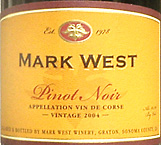2003 Ruffino Fonte al Sole
The juice is 85% Sangiovese and 15% Merlot (all from Tuscany). I'll need to try another bottle - this one has a slight tinge on my nose that could be the beginnings of being corked.
That aside, the palatte is deep and tannic, with a distict cherry smell. The relatively weaker Merlot tempers the brute force Sangiovese for a nice result. I have to mention the color - beautiful deep garnet. Lovely!
In the mouth the wine is smooth and a little velvety. It tastes a little dirty (not always a bad thing), but overall I'd say that this wine is a little angular. I use that description occasionally to describe a wine that, in my opinion, isn't quite rounded, smooth and sublime (think Malbec, Dad, for a good example of round and smooth). This wine may age well, although I'm not sure there is enough there to keep for more than a few years in the cellar.
While I may seem a little down on this wine, I like the structure enough to give it another try. It was pricier than Yellow Tail - about the same price as Cycles Gladiator ($10). I still prefer the Ruffino Chianti (World's best selling Chianti), but I imagine I'll mention this one again on Noble Rot.






